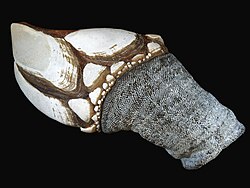| Pollicipedidae | |
|---|---|
 | |
| Pollicipes pollicipes | |
| Scientific classification | |
| Kingdom: | Animalia |
| Phylum: | Arthropoda |
| Class: | Thecostraca |
| Subclass: | Cirripedia |
| Order: | Pollicipedomorpha |
| Family: | Pollicipedidae Leach, 1817 |
Pollicipedidae is a family of goose barnacles. [1] [2]